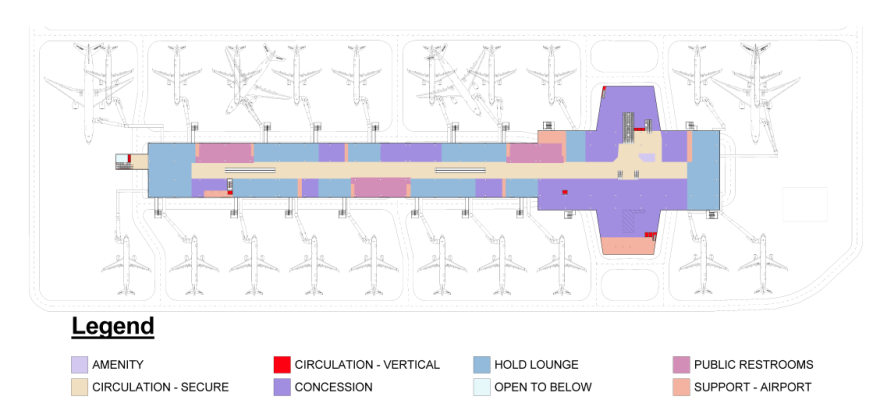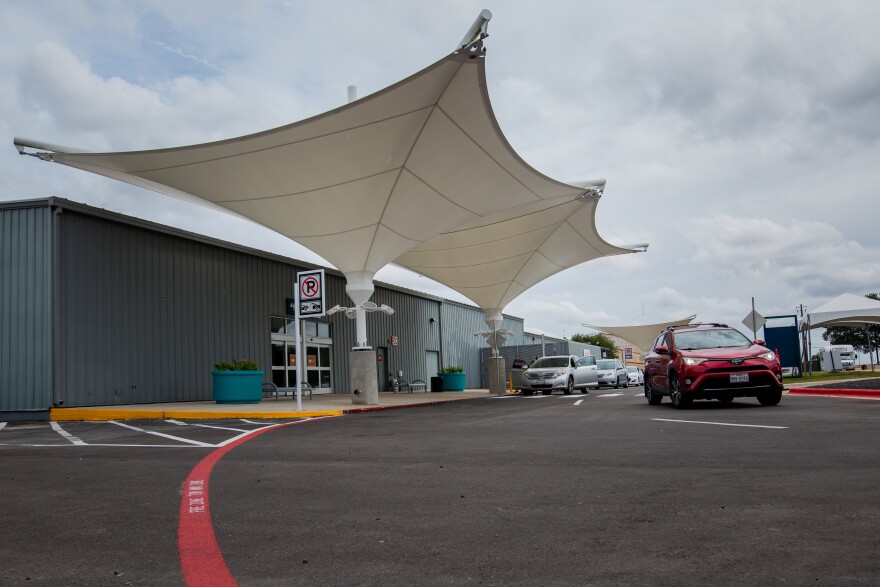The planned gates will be located inside a newly constructed building – temporarily dubbed Concourse B – linked to the main Barbara Jordan Terminal by an underground pedestrian tunnel equipped with moving walkways.

Aviation Department/City of Austin. A bare-bones conceptual illustration of the underground tunnel connecting the Barbara Jordan Terminal to a new concourse. City officials initially preferred an elevated walkway because it would offer more scenic views and avoid potential groundwater issues. However, the city’s Aviation Department concluded that an overhead bridge would make it too hard for planes to move around.
The new concourse isn’t expected to welcome the public until 2030 at the earliest. Over the longer term, the concourse could be further extended to accommodate up to 40 gates, more than doubling ABIA’s current capacity of 34 gates.
Concourse B has been in the planning stages for years, developed as part of a long-term strategy approved by City Council in 2018. That “ABIA 2040 Master Plan” plotted a trajectory for the airport to accommodate 30 million passengers a year by 2037.
Those projections were underestimated by a decade.
ABIA is already serving more than 22 million passengers per year and expects to reach 30 million by 2027. Since the last major expansion – the addition of nine gates on the east end of the Barbara Jordan Terminal in 2019 – ABIA has been equipped to handle only 15 million passengers annually.

Gabriel C. Pérez/KUT News. ABIA opened a nine-gate expansion at the east end of the Barbara Jordan Terminal in 2019.
Despite the heavy traffic, Concourse B has faced repeated delays. The building would have launched this year under the master plan timeline approved by Austin’s City Council, but the airport expansion was grounded when the pandemic hit. Air travel from Austin had plummeted by 97 percent, choking off the airport’s cash flow from airlines, restaurants, parking garages and car rentals – money crucial for funding the expansion.
Once travelers felt safe in planes again, ABIA unexpectedly started shattering all-time passenger records. Within months, the signs of strain were obvious. TSA lines would sometimes snake out the sliding glass doors and onto the sidewalk outside.

Jennifer Harris. TSA security lines stretched onto the sidewalk early on Saturday morning in May 2022 at Austin-Bergstrom International Airport.
City officials scrambled to accelerate the expansion, hoping Concourse B could be ready within a few years.
“In our imagination, it’s (opening) in about 2027, round figures, and we’re going to know more once we get into design,” ABIA executive Tracy Thompson told airport commissioners in July 2021, before quickly adding, “Now that I’ve just said it in a public meeting, please don’t hold us to that date.”
Perhaps because of these missed targets, airport staff are now hesitant to forecast when Concourse B will open. Only under persistent questioning would the airport executive overseeing the project admit the new concourse might be ready by 2030.
“That’s -ish. I don’t have the designer or contractor, so I can’t promise anything,” airport planning officer Lyn Estabrook said. “Maybe ’31, ’32?”
But ABIA is getting serious about hiring a designer for Concourse B. Three weeks ago, the city published a solicitation dangling a $72 million offer to plot out the 635,000-square-foot facility – a building larger than 10 football fields.
And that’s just a taste of the spending to come.

Aviation Department/City of Austin. A conceptual floor plan diagram of Concourse B, included in a solicitation document, suggests where gates, restrooms and other facilities might be located.
The total cost of the new concourse, the underground pedestrian tunnel, the apron (where the planes park) and the associated infrastructure is expected to reach almost $1 billion, Estabrook said. The project represents the single largest increase in gate capacity since ABIA opened to civilians in 1999.
The planned concourse is part of a broader, 10- to 12-year, $4 billion airport expansion, branded Journey with AUS, that includes a new arrivals and departures hall with more ticketing and check-in counters and bigger baggage claim carousels.
The new arrivals and departures area will push north, smashing through the close-in Red Parking Garage. A new parking garage is planned behind the Blue Garage.

Department Of Aviation/City of Austin. The $4 billion airport expansion is made up of more than 60 individual projects.
Shorter-term projects range from a new outbound baggage system to an 80,000-square-foot addition to the west end of the Barbara Jordan Terminal to smaller upgrades like a makeover of the terminal’s restrooms with new fixtures, countertops and mirrors.
Concourse B is just one of more than 60 interlocking projects attempting to elevate ABIA’s capacity to 30 million. Each piece of the puzzle will cost millions of dollars and potentially inconvenience passengers navigating a construction zone. During the construction of Concourse B, for example, planes could take longer to taxi to and from the runway.

Michael Minasi/KUT News. Planes could take longer to taxi to and from the runway while Concourse B is under construction.
The site of the planned concourse is on top of two existing taxiways, which are the roads that guide planes from the terminal to the runway. Those taxiways will need to be ripped up and replaced with new taxiways farther south before the concourse can be constructed.
The new taxiways will have to cross over Emma Browning Avenue, so the project includes two multimillion-dollar aircraft bridges strong enough to hold planes as heavy as the Boeing 777-300, the largest twin-engine passenger aircraft in the world.

Department of Aviation/City of Austin. The new midfield taxiways, shown in white, include aircraft bridges over Emma Browning Avenue and will require ripping up existing pavement and infrastructure.
Pushing the taxiways south to make room for Concourse B will obliterate the South Terminal – a separate facility for discount airlines Allegiant and Frontier – around March 2026. Austin forked out $88 million in a legal settlement last year to claw back the South Terminal from a private equity firm that had signed a 30-year lease for the facility in 2016.
The decision to demolish the South Terminal was made after a series of meetings in 2020 with airport executives, the world’s largest pilots union and the Federal Aviation Administration.
A consultant’s memo, obtained through the Texas Public Information Act, shows officials were concerned that any layout attempting to save the South Terminal would render the new taxiways too costly and cramped, forcing planes to make more turns and take longer to reach the runways.

Gabriel C. Pérez/KUT. The South Terminal, which serves Allegiant and Frontier, opened in 2017 after the company leasing it spent millions of dollars in renovations. It’s now due to be torn down in March 2026 to make way for new taxiways and Concourse B.
Designs for those $324 million taxiways – including the aircraft bridges – are expected to be done later this month. Construction could start this fall and finish in 2027.
As for Concourse B, the project is still distant enough that the city hasn’t decided how many gates will open at first. Mostly, it depends on what airlines want. They’ll be the ones leasing the space.
“If they need 10 first, we will build 10 first and then build the other 10,” Estabrook said. “We have to work closely with the people who are going to be occupying it and running that space.”
This story was produced as part of the Austin Monitor’s reporting partnership with KUT.
The Austin Monitor’s work is made possible by donations from the community. Though our reporting covers donors from time to time, we are careful to keep business and editorial efforts separate while maintaining transparency. A complete list of donors is available here, and our code of ethics is explained here.







